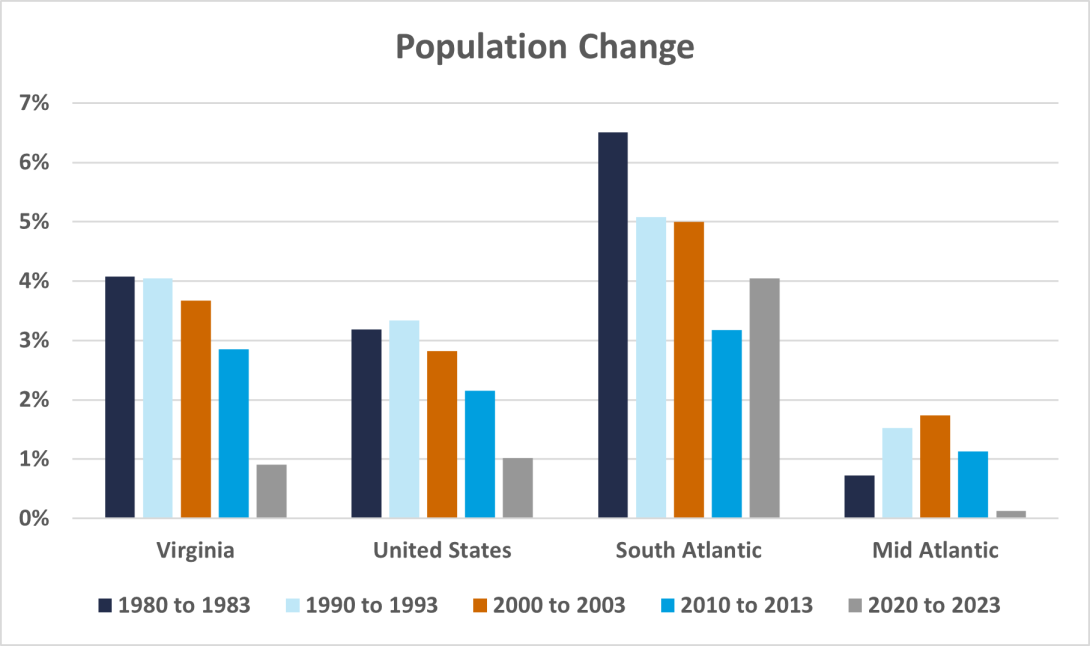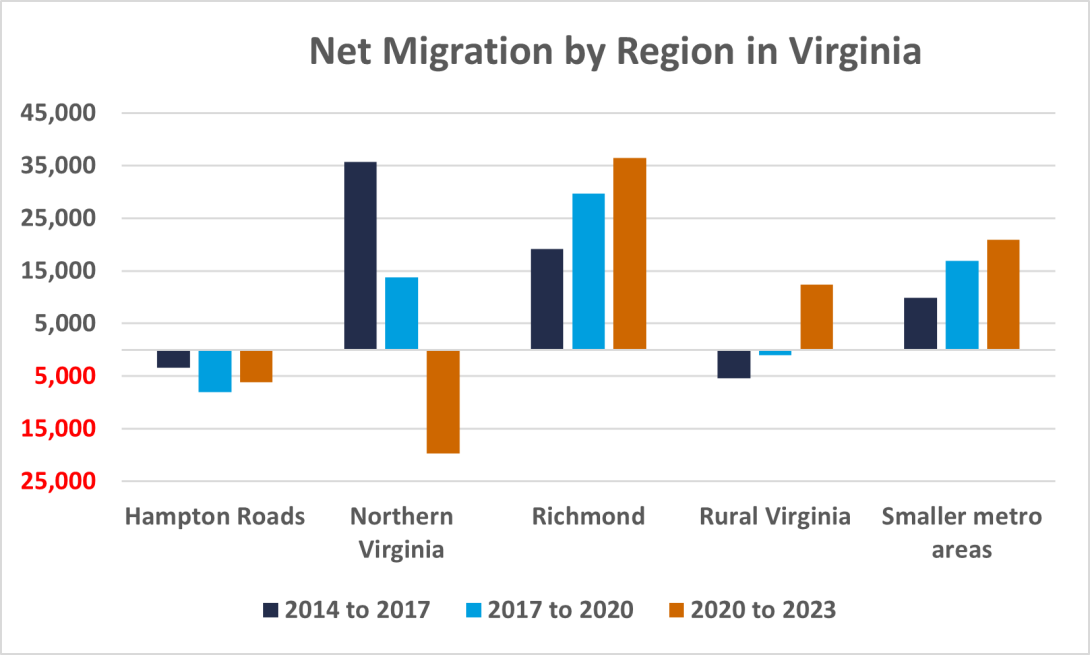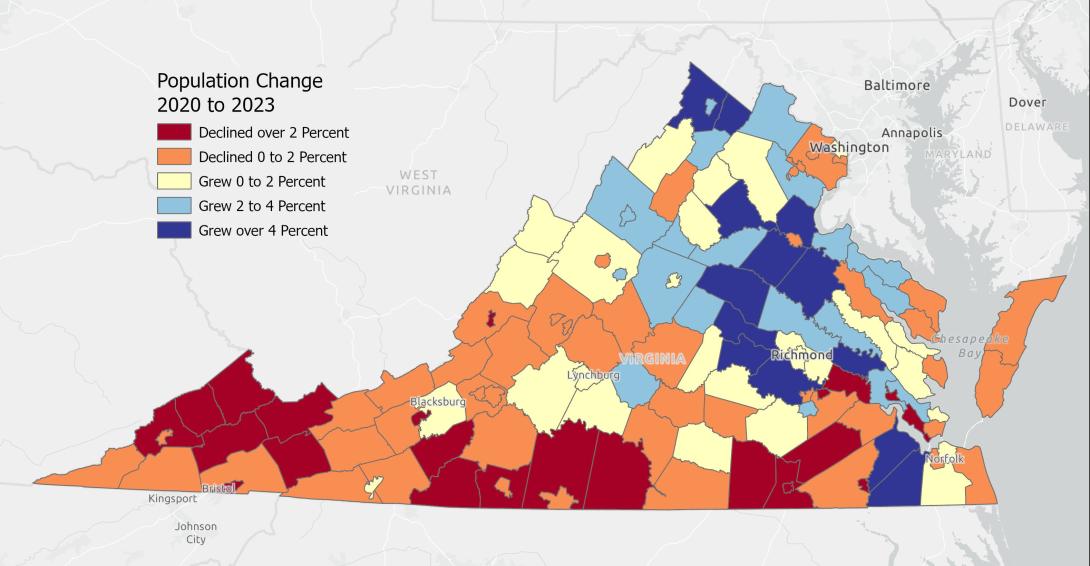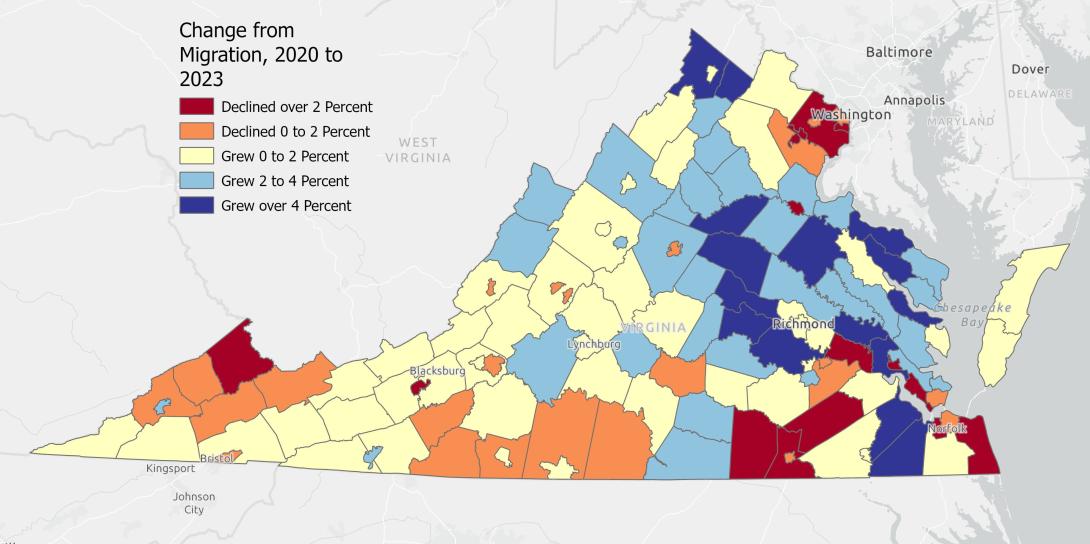Amid slow population growth, Virginia’s demographic landscape is being transformed
In 1972, the Premier of China, Zhou Enlai, famously responded “too early to say” when asked what the impact of the French Revolution would be. Regardless of whether he was referring to the revolution of 1789 or, more likely, the revolution of 1968, his point was the same: the repercussions from significant events can be much more far reaching and long lasting than most imagine. Nearly four years since the pandemic began in the U.S., its repercussions remain a significant source of uncertainty in understanding what demographic trends will look like for what remains of the 2020s. Initially, the pandemic caused the number of deaths to spike and immigration to drop, both slowing population growth temporarily. But the 2023 Virginia county and city population estimates released today by the Weldon Cooper Center show that a more lasting impact of the pandemic has been high levels of migration continuing to flow out of Virginia’s large metro areas into smaller metro areas and rural counties. The persistence of this trend, which mirrors the transformative effect of suburbanization in the last century, will likely attract the public’s attention during this decade, as it is slowly, but significantly, altering Virginia's demographic landscape.

Though growth accelerated in Virginia and across the U.S. in 2023, it remained slower than in recent decades. Between 2022 and 2023, both Virginia and the U.S. grew by less than half a percentage point. For Virginia, this is the slowest it has grown since the Civil War. Some of the slower growth has been the result of death rates dropping only slowly from pandemic highs, while births have not rebounded since falling in 2020. In Virginia, there were less than 13,000 more births than deaths in 2022, a big drop from 27,000 more births than deaths in 2019. An even larger factor behind the slower growth in Virginia and in many states to our north is that since the pandemic, more people are leaving large metro areas, including Northern Virginia, often to southern states, which have seen population growth accelerate since the pandemic.
The flow from large population centers is being felt in nearly every part of Virginia
In 2023, many people continued to move out of Northern Virginia, a trend seen in other big metro areas across the country. Many of these people stayed in Virginia, moving to smaller cities and counties nearby. Migration from Northern Virginia helped the Winchester Metro Area become Virginia’s fastest growing metro area, with its population increasing at nearly five times the rate of Virginia as a whole. It also contributed to Richmond Metro Area’s greatest influx of new residents in its history. The four fastest growing counties in Virginia so far this decade—New Kent, Goochland, Louisa, and Caroline—were all in or adjacent to the Richmond Metro Area.

Some of Virginia's recent migration trends—including movement from larger to smaller metro areas and from city cores to suburbs—echo longstanding demographic shifts that have been shaping the state's population distribution for close to a century. Decades of migration into the Richmond Metro Area and weak growth in western Virginia has meant that at some point early this year, the size of the population in the Richmond Metro Area will have surpassed Virginia’s total population living west of the Blue Ridge Mountains for the first time since before the American Revolution. The national trend in recent years of more migration out of cities into nearby suburbs helped caused the number of residents in Suffolk to pass 100,000 in 2023, after surpassing neighboring Portsmouth in population last year. Similarly, in 2023, Bedford also surpassed neighboring Lynchburg, in population as a result of the largest surge in migration into the county since the peak of the 2000s housing boom.

Migration into Virginia’s rural counties is the most widespread since the 1970s
Yet, examining the 2023 population estimates more closely reveals that Virginia is experiencing a remarkable break from some of its longstanding demographic trends. In 2023, over three-quarters of Virginia’s rural counties outside metro areas had more people move into them than out, the highest share since 1975. So far, this surge in migration, has to some extent, been masked by the high death rates that rural counties’ older population disproportionately suffered during the pandemic. Middlesex, a small rural county located on the Rappahannock River and Chesapeake Bay, has, in recent years, attracted new residents at a similar rate as Frederick County—one of Virginia’s fastest growing counties—yet Middlesex’s population has only grown by 1 percent since 2020 because it had 400 more deaths than births during the period.

Increased migration is already impacting Virginia’s rural counties. Since 2020, more people moving into Virginia’s rural localities has resulted in the fastest increases in home values in the state. Earlier this month, the Weldon Cooper Center released school enrollment projections, which forecast that the ten fastest growing school divisions over the next five years will be mostly in rural counties. As death rates continue to fall during the 2020s, the surge in migration to Virginia’s rural counties should only become more obvious.
The 2023 estimates show few signs of a return to pre-pandemic trends
Migration into Virginia’s rural counties and smaller metro areas has accelerated in recent years, but the 2023 population estimates show a contrasting trend of weak growth and decline in its largest localities as out-migration continues. Fairfax County, Virginia’s largest locality, continued to experience population decline due to out-migration in 2023. Last year in nearby Loudoun County, once Virginia’s fastest growing locality and still its wealthiest, only 11 more people moved in than left. A decade ago, Loudoun was attracting close to 10,000 more residents than left each year.
The same pattern of out-migration seen in Northern Virginia is occurring in most of the country's largest metropolitan areas, indicating that a wider demographic shift is taking place. The rise of remote work has helped fuel this shift, as it offers people the flexibility to move to areas with better living standards and a lower cost of living. So far this decade, among metro areas in Virginia, Northern Virginia has had the highest per capita out-migration rate, while the Bristol Metro Area has had the highest per capita in-migration rate.
The explosion in remote work during the pandemic and its persistence since then is shaping up to be the most impactful demographic trend since expansion of suburbs and exurbs after World War II. While over the past century most population growth was concentrated within commuting distance of major employment centers, such as Washington DC, the large amount of work now done remotely (a third of all workdays in 2023) is helping shift growth much further away from major employment centers. If the impact of remote work even partially echoes the cataclysmic demographic shift that Virginia experienced during post-war suburbanization, Virginia’s population trends will continue to be reshaped by remote work well beyond this decade.


